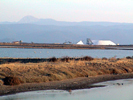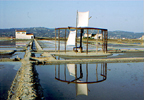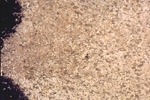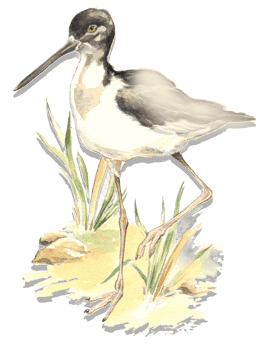| Glances
of interest on Mediterranean salinas
Since
some years Mediterranean salinas have been defended by nature
and cultural conservationists, for the simple reason that they
are unique for their landscape and wetland values, as well as
for making part of the cultural heritage of the Basin. In this
respect, some salinas, once degraded or fallen into ruin, were
recently upgraded, restored and rehabilitated. The raising interest
about them was expressed through symposia and workshops by scientists
(historians, ethnologists, ecologists), managers and owners, local
developers. All agree with sustainable development and wise use
of salinas, where salt-making is combined with soft tourism. In
addition, there have been some Mediterranean initiatives aiming
mainly at raising awareness and networking on the study and conservation
of the salinas. Such initiatives are the Salt Routes of UNESCO,
the current ALAS project financed by the European Commission,
and the recent MedWet/Com4 Technical Session.
The Salt
Routes was a splendid idea arisen from the Paris workshop in April
1997 (DG XI- INSULA, UNESCO). It was followed by the currently running
ALAS (All About Salt) ECOS-OUVERTURE project (1999-2002), the first
Mediterranean collaboration initiative between salinas: of Lesvos
(Greece), Figueira da Foz (Portugal), Piran (Slovenia), and Pomorie
(Bulgaria). The recent MedWet/Com4 Technical Session (Sesimbra,
May 2001) recognizes the importance of ecological, cultural, historic,
landscape, educational and touristic values of the Mediterranean
salinas, the pressures and threats they are currently facing, and
proposes a set of recommendations for their conservation.
|
 |
|
A
traditional salina on the island of Lanzarote
|
|
|
|
|
|
Salinas
of the Mediterranean and their History
The Mediterranean
salinas are usually coastal and man-made. Seawater evaporates in
a succession of shallow ponds, the salt is finally collected or
harvested for domestic and industrial use. Since the eve of civilization,
and due to the diversity of technical solutions, a rich terminology
has developed: saltpans, salterns, salt-gardens, salinas, salines,
saltworks.
The Mediterranean
climate is ideal for salt making. Although a generous gift of nature,
salt has been artificially produced as early as 641 BC in the first
salt-gardens of Ostia (Rome). Already then, later even more, salt
has been an expensive commodity for the Mediterranean, as well as
the world beyond this region. The evolution of salt-making techniques
came to a standstill with the method of successive evaporation basins,
introduced into the Mediterranean by the Arabs in the early Middle
Ages. The basics of this technique remain unchanged until today.
First, the compartments (pre-basin, evaporation ponds of low, medium,
and high salinity, crystallizers), all connected and separated by
canals, gates, sluices, dikes, bridges, aqueducts. Second, the process
that differs only as to the harvest rate varying from few (continuous
crystallization) to many harvests per period (periodical crystallization).
According
to the size, the variety of methodology for salt-making employed,
as well as other characteristics, the following types of Mediterranean
salinas are distinguished:
- primitive
or artisanal salinas, in which salt is gained with little or no
human intervention, mainly collected from nature (e.g. rocky coasts,
closed lagoons etc).
- traditional
salinas, comprising small compartments and crystallizers that
can be efficiently operated by one or two persons. They are
characterized by intense human presence in all stages of salt-making.
- semi-industrial
salinas (rather saltworks), with relatively large compartments
and crystallizers. They are still characterized by involvement
of man and are manually operated at least for salt harvest.
- fully
mechanized huge industrial saltworks, with almost no manual operation,
that are extremely large and economically profitable.
Since
the ancient times, hundreds of salinas have operated in the Mediterranean.
Considering only the non-primitive coastal ones, ca. 170 of them
are recognizable today: 90 are still working, whereas the rest are
inactive or transformed. Of the 90 active salinas, 77% are located
in the northern, European coast, the rest in Turkey, Tunisia, Algeria,
Lebanon, Israel, Egypt and Morocco. Their surface may vary from
1 ha to 12,000 ha. Largely created from areas of natural saltmarsh,
they have developed into areas of major importance not only for
the ca. 7 million tons of salt produced per year, but also for historical,
cultural and ecological reasons.
|
 |
|
Small
salina carved in the rock on Gozo
|
|
|
 |
|
The
Greek salinas are today all semi-industrial. Here Kalloni
in Lesvos.
|
|
|
 |
|
The
biggest salina in the Adriatic, Margherita di Savoia, works
with pluriannual crystallization
|
|
|
|
|
| The
values of the Mediterranean salinas
Economical
and historical value
Mediterranean
salinas are recognized among the most important non-polluting industrial
activities of the area. Their importance has been more pronounced
in the past, when salt was a vital commodity, at least for food
preservation, and played a key role throughout history, providing
political power to those who controlled its production and trade.
The first Salt Routes, through which salt was traded, were probably
those of the Protocycladic II period, in early Bronze Age, later
the Phoenician ones. Amongst the most known, the terrestrial viae
salariae of the Romans, and the marine ones by Venetians and Genoese,
justify the metaphor white gold referring to the economic importance
of this commodity, the renowned "edible money" of Cassiodorus.
Indeed, for many centuries, states, churches, cities, as well as
families acquired power and wealth from producing, trading or simply
taxing monopolized salt (the roman annona, the byzantine kommerkion,
the arab al-quabala, the french gabelle). It is because of its economic
importance that salt makes still part of today’s monthly payments,
at least as a relict in some European languages (salarium, salary).
Cultural
value
Based
on the same basic technique, many varieties of salt-making adapted
to the particularities of geology, the vicissitudes of climate,
the anthropological temptations, challenged the Mediterraneans
to develop a diversity of devices and tame wind and waves for
letting salinas be white. The immense quantity of human energy
invested resulted not only to a simple commodity, but also to
everlasting cultural features: the saline landscape of the Mediterranean,
comprising architectural and technical achievements (devices,
equipment, tools, techniques), as well as social aspects such
as the salter’s life style and manners (materials, housing
etc.). Yet, the salt, basic seasoning and food preservative, served
as the vehicle for the tastes of the European history of gastronomy
since the ancient times: from ÄÁÊÔÒ (gr.)
to garum (lt), salcicia (lt) to sausages, salsa (it.) to sauce,
insalata (it.) to salad, salsamenta (lt) and salgama (lt), salted
herring. Inside the ancient Greek salt cellars, the Roman salina
(sing. salinum), the byzantine alatika, and the Italian saliere,
salt has always had a special place on the table, and a prominent
position in the famous museums. As a profession, it accompanied
many people through life: salters, salgamarii, salt transporters
and traders, salt guides, tax officers and smugglers. Although
notorious, its symbolic significance for human behaviour, customs,
religion, mythology, legends and superstitions is, therefore,
quite understandable.
|
 |
|
A
rich architectural heritage in the Secovlje soline, Piran
|
|
|
 |
|
An
old salt cellar in the saltmuseum, Cervia
|
|
|
 |
|
The
salters' tools are kept close to the Camillione salina,
Cervia
|
|
|
|
|
|
Ecological
value
There
are several reasons for qualifying salinas as important wetland
sites, and interesting from the viewpoint of nature conservation:
First,
because of the special biodiversity they host. This is due to the
hypersaline character of the saline basins, one of the harshest
wetland habitats. Very few organisms can stand the inhospitable
environments of these saline deserts, where, however, they can grow
into extremely large populations due to lack of competitors. This
is why Artemia, the brine shrimp, can grow at incredibly high numbers
in the saltpans, providing other consumers with ideal conditions
for feeding by filtration such as flamingos (Phoenicopterus ruber)
and avocets (Recurvirostra avosetta).
Second,
because salinas are biologically rich despite being artificial habitats.
This is due partly to the fact that as man-managed they are kept
constantly under water, which makes them ecologically invaluable
during the dry summer. In winter, however, their ecological value
may decline the pools are left without water. Their biological richness
is also due to the wetland mosaic consisting of a combination of
basins of a wide salinity gradient, providing diverse niche possibilities
to species of different tolerance. In addition, salinas contain
a number of relatively undisturbed aquatic and terrestrial habitats
that make them vital for the conservation of waterbirds.
Third,
because many salinas constitute the only functioning wetlands among
extremely dry areas such as islands and extended Mediterranean archipelagoes.
The Mediterranean
salinas are artificial idiosyncratic wetland systems, characterized
by:
- -
the presence of equally uncommon species: salinity tolerant unicellular
organisms, some of them interfering with the quality of salt produced
(Aphanotheca, Dunaliella salina, Halobacterium);
- -
an interesting halophilous flora, aquatic and terrestrial, the
latter pollinated by a specialized wasp fauna;
- -
quite diverse salinity tolerant aquatic invertebrates, few fish
genera;
- -
a considerably high diversity of waterbirds using the salinas
for breeding (often in large colonies) or as wintering and refueling
sites during their transcontinental stopovers.
Is
the ecological value of a salina size-related? To put it otherwise,
are small salinas inferior than large ones? The answer cannot
be simply yes or no. This is because on the one hand, large salinas
are endowed with unique ecological characteristics, whereas small
ones are sometimes unique within extended, dry areas. This makes
the latter invaluable from the viewpoint of nature conservation.
In addition, ensuring water circulation in them throughout the
year is less complicated compared to managing the large ones.
|
 |
|
A
dense 'cloud' of Artemia salina in the salinas of Guerande
|
|
|
 |
|
The
chicks of avocets easily find food in the shallow water
|
|
|
 |
|
The
hyper saline waters are coloured by different micro organisms,
Castro Marim, Portugal
|
|
|
 |
|
Coots
and wintering geese in an Atlantic salina
|
|
|
|
|
| Pressures
and threats to the Mediterranean salinas
Mediterranean
salinas are today facing many pressures and threats due to change
of social values and economic stresses, notably:
- conversion
from low intensity to mechanized production. Worst is the transformation
to high salinity brining salinas of almost no biological value.
- abandonment
or conversion to other uses such as ports and airports, aquaculture
and rice farms, industrial, urban or tourist zones.
These
impacts affect the salinas’ role as a cultural landscape and
the coexistence of sustainable salt production and biodiversity.
Landscape quality may be additionally affected by occasional pollution
events, marine (e.g. oil accidents) or terrestrial (wastes, sewage).
The fragile
socioeconomic balance is linked to a market that is subject to competition
from cheaper land-produced salt and the world trade. Faced with
the need to be economically viable, Mediterranean salinas are confronted
with the choice of closing, industrializing the production, or finding
a niche market for quality salt that gives higher market returns.
Where salinas close, this leads to a significant loss of their biodiversity.
In the cases of transformation into other farming use, they definitely
loose their ecological values. The current trend to cease, or consolidate,
salt production in many parts of the Mediterranean has created many
inactive and intermittently exploited salinas with buildings and
hydrological infrastructures falling into ruin. This is exacerbated
by competition for space along the Mediterranean coastline for urbanization,
industry, and tourism, especially on the northern edge where the
largest number of dormant salinas is found.
Experiencing
on conservation and public awareness
The friends
of Mediterranean salinas can share common interests with two important
current initiatives:
- The
ALAS project, with ambitious objectives to be achieved through
active networking:
- Development
of specific local concepts on the production and use of traditional
salt to maintain/create jobs, and conservation of the salinas
cultural and natural heritage as an important factor of regional
development;
- Enhance
the wetland values of the salinas through drafting and implementing
ecological management plans;
- Conserve
small salinas through promoting and marketing traditionally
produced salt as a high-quality product (economic study, labeling,
setting-up co-operative structures);
- Conservation
of the salinas heritage through compilation of knowledge on
traditional salt production and related cultural heritage,
together with preparation of guidelines and execution of pilot
projects on re-establishing/upgrading/operating traditional
salinas including training of qualified salters;
- Establishing
or improving salt-museums for raising awareness on cultural
and natural heritage of salinas;
- Experimenting
to use the cultural and natural heritage of salinas and traditional
salt for additional quality tourism.
- The
initiative of the recent MedWet/Com4 Technical Session. Among
the substantial conclusions on the future action for the "wise
use of salinas", it encourages MedWet/Com members to support
existing networks and programs on the conservation of salinas,
and it recommends:
- the
establishment of a multi-sectoral MedWet Salinas Working Group,
with responsibility to report to Ramsar COP8 on the status
and trends of Mediterranean salinas;
- include
salinas and salt into the Millennium Ecosystem Assessment;
- promote
awareness and a multi-sectoral "wise use of salinas"
network in collaboration with relevant existing sites and
project networks such as ALAS.
Theodora
PETANIDOU
University
of the Aegean
Department of Geography
E-mail: t.petanidou@aegean.gr
|
 |
|
When
abandoned the salina dries out and loses most of its ecological
interest. Here Comachio in the north Adriatic
|
|
|
 |
|
The
salina on the Aegean Samos was abandoned in 1965
|
|
|
 |
|
Many
salinas have been transformed inte basins for aquaculture
or fish farming. (Brouage in France.)
|
|
|
 |
|
One
way to valorise the traditional salt: a more elaborate packaging
than simple plastic bags
|
|
|
|
|


